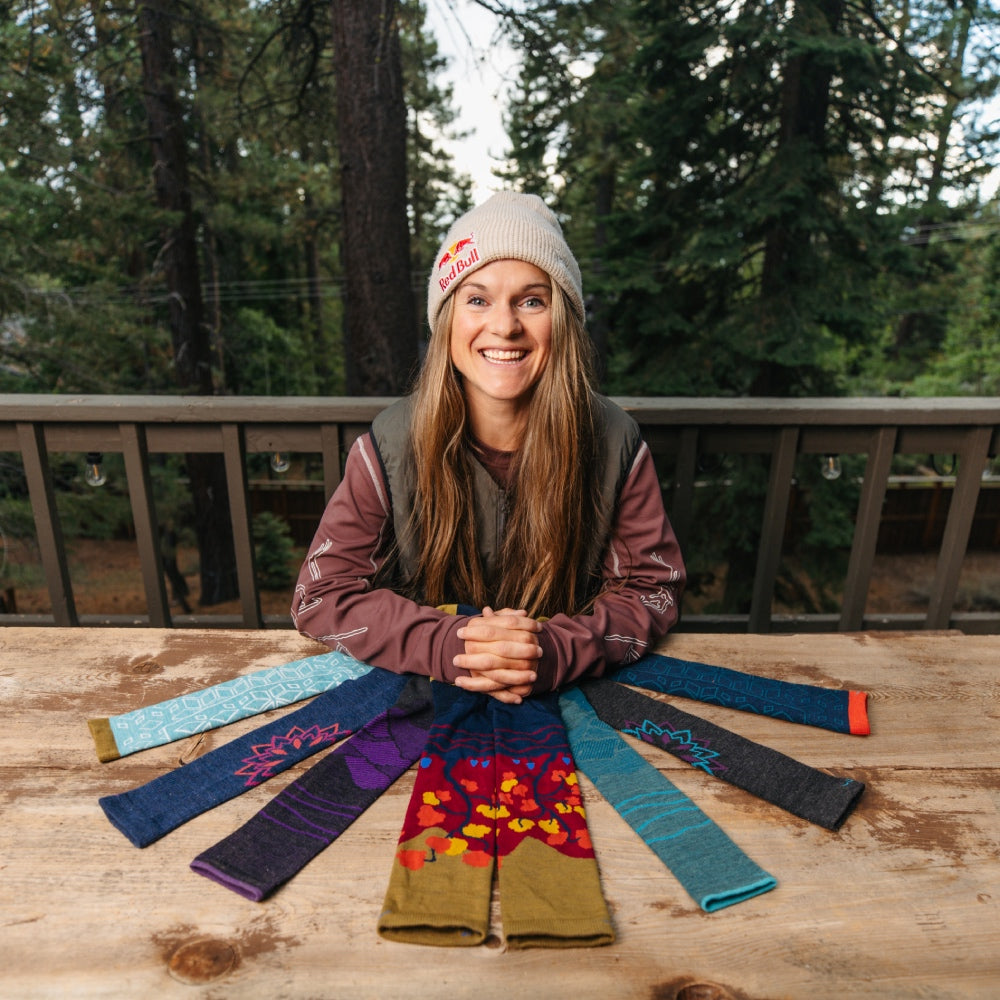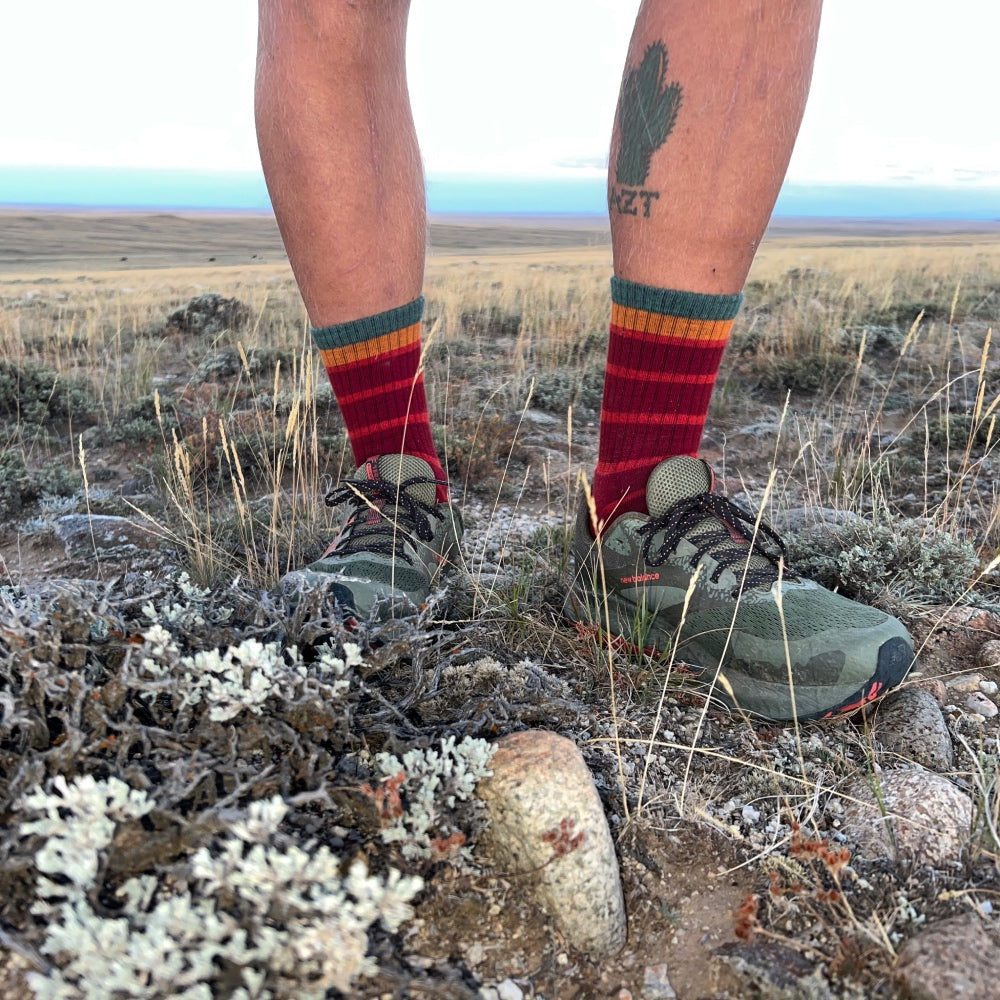Sock Marks: Why They Happen & What to Do About Them

If your socks make an impression (beyond just what people think of them) then you’re going to want to read this article. We’re covering performance socks: what they are, how to ensure they fit, the benefits they offer, and the marks they (might) leave behind.
We’ll go into why performance socks sometimes leave marks on your legs, how peripheral edema is involved, and what you need to know about reducing swelling and unwanted sock marks. We’ll also share some red flags you should be aware of to help you determine when the swelling you’re experiencing needs medical attention. Let’s jump in.
What We Mean by Performance Fit
To us, performance fit means socks that closely hug feet like a second skin, that move and flex to deliver activity-specific comfort and protection, and that resist wear and tear for superior durability.

Depending on which category of Darn Tough socks you’re considering (hiking, running, every day, snow, hunting, work and tactical) you will find the exact formulation for performance fit differs while the essential ingredients stay the same:
- All Darn Tough socks begin with naturally soft and thermoregulating Merino Wool
- We add stretchy nylon and spandex fibers for maximum comfort, durability, and fit
- Performance is enhanced with specific combinations of cushion, knitting techniques, and flex
At Darn Tough, socks are our sole focus. We like to say we have yet to knit our best sock, and that means we are continuously learning and striving to improve our socks, so they deliver the benefits you expect from a premium performance base layer.
With decades of knitting experience, and our warranty, design, and manufacturing teams in-house at our Vermont Mills, we have the data and context to tell us that a snug fit is the best choice for socks that will protect foot health and last a good long time.
How to Tell a Close Fit vs. Tight Fit
Since performance socks are designed to hug feet and legs, let’s consider how to tell the difference between a sock that has a close fit vs. a tight fit.
The simplest way to determine if your socks are properly close fitting or too tight is to wear them for a day. Go ahead and put on the pair in question. Don’t feel alarmed if it takes a little effort to pull them into place – for our socks that’s normal. Get your shoes on and go about your day.

When you’re ready to take them off, ask yourself whether you noticed those socks throughout the day. Generally speaking, if the answer is no, then you’ve got yourself a pair of close-fitting socks that are not too tight for you.
If your socks are too tight, the bottom line is that you’re going to be relentlessly aware of them the whole time they are on. You might need to keep tugging on them or feel like they are limiting your range of motion or connectivity with your footwear; they might even feel like they’re putting too much pressure on your feet and legs – pressure that you can’t ignore.
If your socks are tight and feel like they are causing you pain, it makes sense to take them off ASAP and try a different pair.
To be clear: just because a sock is snug does not mean it is too tight. Some socks are snug by design. And sometimes, you need to try a few pairs and sizes to figure out what works best for you.

DYK: Darn Tough has one of the best guarantees out there. If you try a pair of our socks, and they aren’t the right fit for you, you can return them to us (no questions asked), and we’ll help you get into a different pair. We also maintain a searchable directory of local shops that carry our socks, so you can find a place near you to get some in-person advice and maybe try before you buy.
A Close Fit Is Like a Second Skin, and That's Good
Darn Tough socks are intentionally designed with a close fit that acts like a second skin. That means it is normal for them to feel like they are hugging your feet and legs when you first put them on. After a short time wearing them, they should feel like they’ve become one with your feet, and you might even forget they’re on.
Here are 3 reasons why snug performance socks are a good thing:
- Snug socks protect foot health by flexing and moving with the body, instead of against it, preventing blisters and providing support
- Snug socks that blend Merino Wool with stretchy elastic fibers are more durable and perform longer, meaning you buy less frequently
- Snug socks resist wear and tear, meaning they stay in service much longer
Let's Talk about the Marks Socks Make
Now that we’ve gone over performance fit and why it matters, let’s look at why socks leave marks, how you can reduce the appearance of sock marks and get them to disappear more quickly, and when you may need to be concerned.

Why Socks Leave Marks on Legs
To put it simply, socks leave marks on legs because of pressure from stretchy fibers they are knit with. For instance, all Darn Tough performance wool socks include some nylon fibers to increase durability and spandex to improve their comfort and fit. Stretchy synthetics are why our socks hug your feet and also why they can leave an imprint on your legs.
Another factor that can cause sock marks to be more noticeable is the presence of fluid retention (aka swelling or peripheral edema) in the feet and lower leg. This type of mild to moderate swelling is normal and usually harmless.
Here are 5 things that may affect swelling in the lower legs, increasing the likelihood of socks leaving indentations:
- Extended sitting or standing
- Dehydration
- Heat
- Hormone changes
- Age & weight
Reducing Sock Marks on Legs: Hydration & Movement
Sock marks likely aren't hurting you... but if they bother you, here's how you can reduce swelling and thus reduce the marks.
One way to help reduce swelling in your feet and legs is to focus on proper hydration. Dehydration can cause your body to retain fluid, which leads to swelling. Being properly hydrated can help prevent unwanted swelling and reduce the appearance of socks marks on your legs.
Of course, tending to your hydration isn’t always as simple as just drinking 64oz of water daily, but it’s a good place to start. So go fill up your water bottle. We’ll wait…

In addition to hydration, regular movement is another thing you can do to help reduce unwanted swelling in your lower extremities. The simple explanation here is that when you sit or stand for long periods of time, gravity and muscles that go off-line because they aren’t being used both contribute to a buildup of fluid in the lower legs and feet.
If it’s an option for you, make it a priority to move regularly during your day, especially if you have a job that keeps you sitting or standing in one place for long periods of time. March in place, set a timer to do some stairs once every hour, or take the long way to fill your water bottle…just keep your body moving to keep that fluid circulating and not pooling.

Hot Tip: If you’re moving regularly… you might need a little extra hydration! The two go hand in hand.
When You Should See a Doctor About Swelling
If you notice your socks leaving marks on your feet, ankles, or lower legs this can be a sign that you are experiencing some fluid retention or swelling. Mild to moderate swelling in lower legs and feet is common and most often harmless.
The amount of swelling we experience can be affected by the food we eat, our hydration levels, hormone changes, age, etc. and some fluctuations are considered normal.
However, if you experience any of the following, please contact your doctor ASAP and get checked out:
- Swelling in only one foot, ankle, or lower leg
- Worsened swelling in conjunction with heart or kidney disease
- Sudden increase in swelling if you are pregnant
- Pain, tenderness, warmth, or redness associated with swelling in your foot, ankle, or lower leg
- An open wound or other injury associated with swelling
- Severe swelling that has no apparent reason
If you experience swelling and you are having difficulty breathing, coughing, chest pain, confusion, dizziness or fainting, dial 9-1-1 for immediate help.
Find Your Sock Fit
We knit our socks with a performance fit and size them based on standard shoe sizes... but everyone is different, and everyones feet are different. We value those differences and, while we're on the journey to knitting our best socks, we don't have it perfect yet. But we're committed to the journey, and we're investing in relationships to help guide us there. Partners like Mirna Valerio give us invaluable feedback to make our next socks better than the previous ones.

If your Darn Tough sock is leaving unwanted marks due to a fit issue, we want to help. Our Customer Service team is eager to answer your questions and help you find the best fit for you.
TL; DR
- Swelling in our feet and lower legs is common and usually harmless.
- Snug clothing, like performance socks knit with stretchy elastic yarns, is prone to leaving marks on swollen skin.
- You can do some things to reduce swelling (or fluid retention) in your feet/ankles/lower legs, like staying properly hydrated and moving regularly (especially if you sit or stand still a lot).
- There are some instances where swelling should be looked at by a doctor.







